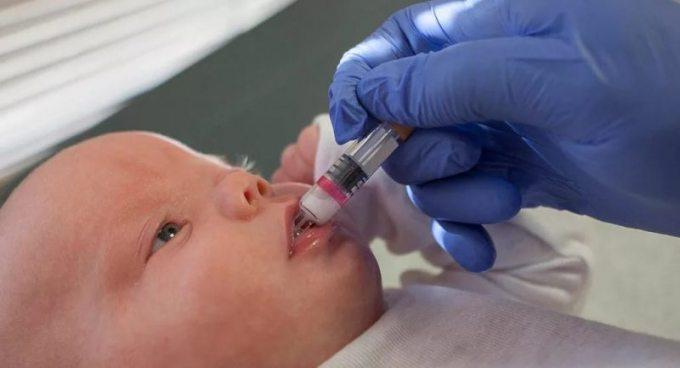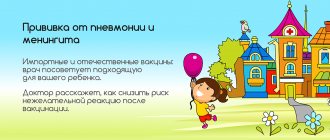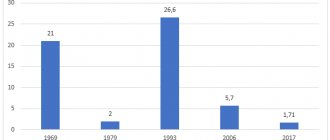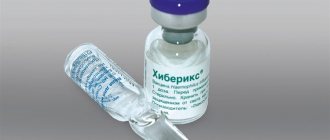Vaccine options
Current vaccines are based on the production of live attenuated strains of rotavirus of human and/or animal origin that multiply in the human intestine.
There are two rotavirus vaccines on the international market: monovalent (RV1 - Rotarix) and pentavalent (RV5 - RotaTek). The RV1 vaccine is based on a human strain, while the RV5 vaccine contains 5 recombinant viruses based on human and bovine strains. In Russia, the RotaTek vaccine (pentavalent RV5) is used - it is oral and contains 5 recombinants of rotaviruses obtained from human and bovine parent strains of the virus. The interchangeability of RV1 and RV5 vaccines has not been studied.
Moderna mRNA-1273 vaccine: effectiveness of protection against coronavirus
Moderna has summed up the results of a clinical trial of its preventive vaccine, mRNA-1273, designed to protect against infection with the new coronavirus SARS-CoV-2 and/or prevent the development of the coronavirus infection COVID-19 caused by it.
The final protective efficacy of the mRNA-1273 vaccine was 94.1% . In other words, we can hope that, with the indicated probability, vaccination will reduce the risk of catching coronavirus and/or getting sick from covid. Or, to put it another way, after vaccination, the chances of encountering Covid will decrease by 20 times .
Given that the coronavirus infection COVID-19 will most likely become a seasonal phenomenon, and the virus itself is slowly but mutating, next year 2021 it may be necessary to slightly adjust mRNA-1273 to take into account the characteristics of new strains of the pathogen that have spread. Moderna maintains that updated versions of its vaccine will pass regulatory review without the need for lengthy clinical trials.
Principles and purposes of vaccination
Rotaviruses infect almost every child before they reach the age of 3-5 years and are the world's leading cause of severe diarrhea with dehydration in children aged 3-5 years. Every year in the period before the introduction of the vaccine (1986-2000), more than 2 million children around the world were hospitalized for rotavirus infection. WHO estimates that in 2008 there were approximately 453 000 (420 000 – 494 000) deaths among children associated with rotavirus gastroenteritis (RVGE) worldwide.
Currently, there is no specific therapy for rotavirus infection. WHO recommends that rotavirus vaccines should be included in national immunization programs and considered as a priority, especially in countries with high mortality rates associated with RVGE, such as countries in South and Southeast Asia and sub-Saharan Africa. The use of rotavirus vaccines should be a component of a comprehensive strategy to control diarrheal diseases. By the end of 2013, rotavirus vaccine had been introduced in 52 countries, and vaccine coverage had reached 14%.
The first dose of rotavirus vaccine, according to WHO recommendations, should be administered as early as possible - when the child reaches 6 weeks of age. The RV1 vaccine must be given twice, and the RV5 vaccine must be given three times. Both vaccines are given orally, with at least 4 weeks between doses. The RotaTek vaccine can be administered on the same day with any other vaccines (DPT, inactivated polio vaccine, vaccines against Haemophilus influenzae and pneumococcal infections, etc.) except oral live polio vaccine.
How to use the vaccine
To vaccinate with Rotarix, the child’s head is tilted slightly and the contents of the container are poured into the mouth. In this case, the doctor should aim at the mucous membrane of the cheek. The drug is not used by injection. A course of medication is two doses of the drug.
The first time vaccination is given to infants from one and a half months, then a break is taken and the 2nd dose is administered. Vaccination must be completed no later than the child turns 6 months old.
Do not administer a double dosage of medication at once. If the baby burps and all the medicine comes out, then the vaccination is repeated. This is done only when you are absolutely sure that the medicine has come out.
Children aged one and a half to six months are most likely to become infected with rotavirus. If the disease occurs, they may experience conjunctivitis, rhinitis, and an increase in temperature. Such infants become lethargic, eat poorly, experience diarrhea, frequent regurgitation, and stomach pain.
A particular danger for a small child is dehydration from loss of water due to regurgitation and diarrhea. Violation of the water-salt balance has a detrimental effect on the brain and can even lead to the death of the infant.
Rotarix is not used for children aged 12 months because their intestinal microflora begins to develop, which reduces the risk of infection.
Vaccine effectiveness
WHO recommends preventive vaccination as an effective remedy against rotavirus. Current vaccines demonstrate 80–90% effectiveness against severe rotavirus gastroenteritis (RVGE) in countries with very low or low mortality rates in children and adults, and 40–60% effectiveness in countries with high mortality rates in children and adults. high or very high mortality rates among adults. In developed countries, a decrease in the incidence of RVGE was observed several years after immunization. In Mexico and Brazil, vaccination resulted in a 22% to 28% reduction in diarrhea-related deaths among children 2 years of age and younger.
In most cases, vaccination in infancy provides protection against severe RVGE for at least 2 years (the period of greatest risk).
Infants can receive rotavirus vaccine along with DTP, regardless of the time of vaccination. Rotavirus vaccinations for children over 2 years of age are not considered inappropriate. Rotavirus vaccines may be given at the same time as other routine childhood vaccines except live oral polio vaccine.
Rotavirus infection
This is an infectious disease that disrupts the functioning of the gastrointestinal tract. Children are at risk. A virus penetrating the body reduces immune defense, provokes vomiting and nausea, and diarrhea. During illness, the patient's body temperature rises to 39 degrees. Doctors have not developed a universal treatment regimen; it is aimed at suppressing the most aggressive signs of the disease.
Infection occurs through the fecal-oral route, through household items, and dirty hands. During treatment, the patient must remain in bed and take medications prescribed by doctors. With timely treatment, the prognosis is favorable and the person recovers in 7–10 days.
Infants are characterized by a severe and moderate form of the disease with rapid dehydration and weight loss:
- With a mild form of the pathology, the child eats poorly, is lethargic, and is irritated. His temperature rises to 37.5 degrees. After eating, the baby vomits and diarrhea appears;
- With moderate severity of the disease, the temperature can rise to 38 degrees, regurgitation and vomiting begin. Defecation occurs up to seven times a day. Stool upset for up to three days;
- A severe form of rotavirus infection is characterized by vomiting up to 15 times a day. This provokes serious dehydration, which threatens the life and health of the child. The mucous membranes become dry. The average recovery time with appropriate treatment reaches 10 days.

Treatment of infants is carried out in several areas:
- Replenishing lost moisture. To do this, the child is given a lot to drink, Regidron and other balancing solutions are used that stop moisture loss;
- Restoration of microflora with the help of probiotics containing lacto- and bifidobacteria in their composition;
- Temperature drop. For this purpose, rectal suppositories are used. The dosage and drug are selected by the doctor.
But the most adequate remedy for rotavirus infection is its prevention with vaccines. This procedure reduces the risk of infection. If he gets sick, his form will be mild, in comparison with children who have not undergone this procedure.
More about Rotarix
Rotarix vaccine is a product of English pharmacologists. It is available in the form of a transparent suspension. Timely vaccination with the drug helps reduce the negative effects of rotavirus on the body and forms a stable immune defense inside the intestine.
A vaccinated patient subsequently minimizes the risk of contracting not only rotavirus, but also other intestinal infections. This vaccine is used for preventive purposes in more than 100 countries around the world. Doctors note its good tolerability, minimal side effects and the possibility of simultaneous use with other drugs.
Rotarix contains several types of pathogen, water, sucrose and other components. Rotarix is packaged in a tube or applicator that contains a single dosage of the drug. From 5 to 100 units of vaccine are placed in a box of the drug.
Indications
Rotarix is used prophylactically to reduce the risk of gastroenteritis. It is intended for infants from one and a half months to six months. During this period, infection with rotavirus is most dangerous, since in infants the body quickly loses water, which can lead to the death of the baby.

Rotarix vaccine is intended for oral administration and is not used for vaccinations. During vaccination, the child’s nutritional pattern does not change. Breastfeeding with mother's milk does not reduce the effectiveness of the formation of immune defense, therefore, when taking Rotarix, feeding is not canceled.
Contraindications
The Rotarix vaccine is not recommended for use in infants who are prone to allergies, are sensitive to drug components, or have an underdeveloped gastrointestinal tract due to a congenital anomaly.
Explanations for using the medicine
If you do not understand how to prepare the contents of a Rotarix bottle, the instructions for use do not recommend mixing Rotarix with other medications in the same syringe.
Sometimes you may notice a sediment in the syringe if you store it with solvent. Shake the medicine and make sure there are no foreign particles in the liquid. If the medicine contains flakes, it should not be used.
Popular Features of the Vianvac vaccine and instructions for use
How to prepare the medicine
The plastic cap is removed from the bottle with the lyophilisate, then the adapter is attached to it so that there is a clear adhesion to the container.
After this, the syringe with the contents is shaken vigorously until the liquid turns into a homogeneous mass. After this, the cap is removed from the syringe and its tip is connected to the adapter. The liquid from the syringe is poured into a bottle with lyophilisate. The bottle is shaken again and poured into the syringe, then the adapter is disconnected.
Contraindications
The main contraindications for vaccination against rotavirus infection are a severe allergic reaction to the previous dose and severe immunodeficiency. Cautions for the use of rotavirus vaccine include a history of intussusception or intestinal malformations, chronic gastrointestinal diseases, and acute severe illness. Vaccination should be postponed if the child has acute gastroenteritis or fever due to severe or moderate illness.
How to prepare for vaccination
The use of Rotarix does not require special measures to prepare for vaccination, but it is necessary to visit a doctor and obtain his opinion on the child’s condition. This is done before any vaccination or vaccination. Parents should notify the doctor if the child has an intolerance to any medications or diseases.
Taking the medicine is prohibited if the child has a high temperature, has diseases of the respiratory system (ARVI, acute respiratory infections), or bowel dysfunction. It is not recommended to administer the medicine if the child is vomiting. A complete refusal to vaccinate is necessary. The procedure is simply postponed until complete recovery. While using Rotarix, you should not transfer the child to artificial nutrition if the mother is breastfeeding.

How does interaction occur with other drugs? Rotarix can be used simultaneously with vaccinations against hepatitis, whooping cough, polio, etc. However, medications should not be mixed. Simultaneous vaccination procedures for oral polio and rotavirus infection may impair the formation of immunity from the virus.
When will the Moderna mRNA-1273 vaccine appear in Russia?
Most likely never!
Russia, following the traditional order, has chosen its own path in the task of providing the population with vaccines. Residents will be vaccinated against coronavirus with domestic vaccines. There are three known to be undergoing clinical trials:
- Sputnik V, or Gam-COVID-Vac: a combination vaccine based on adenoviral vectors;
- EpiVacCorona: vaccine based on peptide antigens;
- as yet unnamed: inactivated whole virion vaccine.
Perhaps the green light will be given to the anti-Covid vaccine AZD1222, developed by the Anglo-Swedish AstraZeneca and providing protection at an average level of 70%.
It is possible that Chinese anti-Covid vaccines developed by Sinopharm and CanSino Biologics will be introduced: the first is engaged in two vaccine preparations based on inactivated viruses, the second has come up with an adenoviral vaccine.
The development of Russian coronavirus vaccines is financed from the state budget, and therefore, when mass immunization of the population begins, vaccinations against covid will be provided free of charge. Vaccines from foreign manufacturers, if any, will be offered for money.
Anti-Covid vaccines of the second wave
Following the first-tier preventive coronavirus vaccines, anti-Covid vaccine drugs from other manufacturers will appear. And they will do it much faster.
To do this, the government's Operation Warp Speed program and the support of the FDA are standardizing so-called correlates of immune protection, which will make large-scale randomized clinical trials with a placebo control group unnecessary. We are talking about assessing the degree of vaccine protection not by the results of clinical trials (long and expensive), but by the level of neutralizing antibodies (taking into account changes over time) that are produced by the immune system in response to the introduction of any experimental vaccine against the new SARS coronavirus -CoV-2. It is possible that it will be possible to identify an unconditionally clear connection between the antibody titer and the strength of the immune system that protects against infection and/or the development of infection. Certification of correlates of immune protection is expected to be completed by the second quarter of 2021.
- The public-private partnership Operation Warp Speed (OWS) was initiated in early April 2021 by the Trump Administration to facilitate and accelerate the development, production and distribution of anti-Covid vaccines, therapeutics and diagnostic systems. The US Congress allocated $10 billion for the implementation of the program, although in reality much more is spent: the budget has already amounted to $18 billion. Faster Light Speed finances (including indirectly) the development of coronavirus vaccines from the following pharmaceutical companies: AstraZeneca, Johnson & Johnson, Merck & Co., Novavax ( Novavax), Sanofi/GlaxoSmithKline, Vaxart/Emergent BioSolutions, Inovio Pharmaceuticals.




